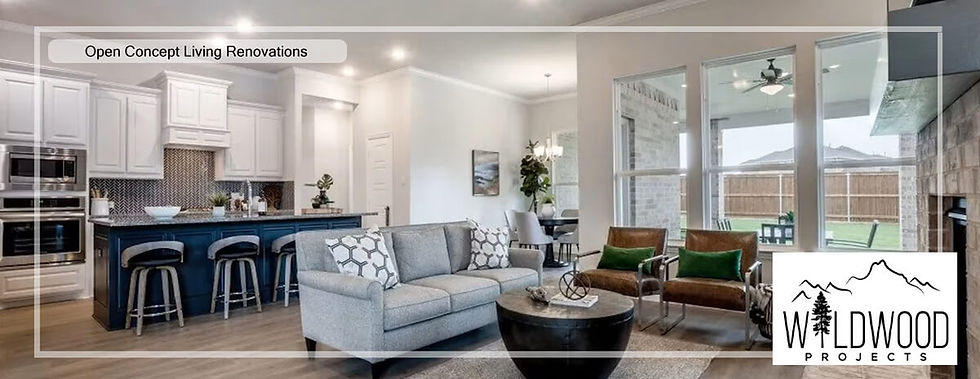Maximizing Small Spaces
- wildwoodprojects

- Aug 25
- 4 min read

Maximizing Small Spaces: Smart Tips for a Bigger, Brighter Home
Living in a smaller home or apartment doesn’t mean you have to sacrifice comfort, style, or functionality. In fact, small spaces can be some of the most creative and well-designed interiors when approached with the right strategies. With a little planning and the right design choices, you can transform even the tightest corners into practical, beautiful, and inviting areas. Whether you live in a compact city apartment or a cozy home with limited square footage, these ideas will help you maximize your small space and make it feel larger than it really is.
1. Embrace Multi-Functional Furniture
One of the most effective ways to maximize a small space is by investing in furniture that serves more than one purpose. Think beyond traditional pieces and look for items designed with storage and versatility in mind.
Sofa beds can transform your living room into a guest room.
Ottomans with storage provide a place to rest your feet while doubling as hidden storage for blankets, books, or toys.
Murphy beds fold up against the wall, freeing up valuable floor space when not in use.
Drop-leaf tables expand when you need them but tuck away compactly when you don’t.
This type of furniture allows you to create flexibility in your space without overwhelming it.
2. Use Vertical Space
When floor space is limited, think vertically. Walls are often underutilized in small homes, but they can provide a surprising amount of storage and design opportunities.
Install floating shelves for books, décor, or plants.
Add wall-mounted racks or hooks for coats, kitchen utensils, or even bicycles.
Consider tall, slim cabinets that maximize storage without taking up too much room.
By shifting storage off the floor and onto the walls, you free up room for movement while keeping your space organized.
3. Opt for Light Colors and Natural Light
Light has a powerful effect on how big or small a room feels. Small spaces benefit from bright, airy palettes and plenty of natural light.
Stick to light paint colors such as whites, soft grays, pale blues, or neutrals to open up the space visually.
Use mirrors strategically to reflect light and create the illusion of a larger room.
Keep window treatments minimal—sheer curtains or blinds let in more light and avoid making the room feel closed in.
The brighter your space, the more expansive it will appear.
4. Declutter and Organize
Clutter is the enemy of small spaces. Too many items out in the open can make a room feel cramped and chaotic. Staying organized is key.
Keep surfaces like counters, coffee tables, and dressers as clear as possible.
Use storage bins, baskets, and drawer organizers to keep items out of sight.
Adopt the “one in, one out” rule: when you bring something new into the home, donate or remove something else.
Minimalism doesn’t mean giving up everything you own—it means being intentional about what you keep.
5. Create Defined Zones
Even in a studio apartment or an open-concept space, defining different zones makes the area feel larger and more functional.
Use area rugs to separate the living space from the dining area.
Arrange furniture strategically to create natural divisions between zones.
Consider room dividers such as open shelving or folding screens that provide separation without closing off light.
When your space is organized into functional areas, it feels more like a complete home instead of one large multipurpose room.
6. Think Compact and Custom
Not all furniture is designed with small homes in mind. Choosing compact or custom-built pieces ensures that you get maximum use of every inch.
A built-in bench with storage in the kitchen or entryway saves space while adding seating.
Corner shelves or desks make use of spots that are often wasted.
Custom closet organizers can double or triple your storage capacity compared to standard setups.
Investing in made-to-measure solutions pays off in both style and functionality.
7. Add Personality Without Overcrowding
Small spaces don’t need to be boring or bare. Adding personality makes your home feel welcoming, but the trick is balance.
Choose statement pieces like bold artwork, a unique light fixture, or a colorful accent chair instead of filling the room with small trinkets.
Incorporate plants to bring life and freshness without overwhelming the room.
Stick to a consistent color scheme to create visual flow throughout the space.
A few carefully chosen pieces will stand out more in a small space than dozens of competing items.
8. Keep It Flexible
Small spaces work best when they can adapt to different needs. Try to keep layouts and furniture arrangements flexible.
Furniture on casters can be moved around to suit different activities.
Folding or stackable chairs can be tucked away when not in use.
Modular shelving or sectional sofas allow you to reconfigure your space as your needs change.
This flexibility ensures that your small home can accommodate both everyday living and special occasions.
Final Thoughts
Maximizing a small space is all about making smart choices, staying organized, and thinking creatively. By embracing multi-functional furniture, using vertical space, choosing light colors, and keeping clutter under control, you can create a home that feels comfortable, stylish, and surprisingly spacious.
Small spaces may present challenges, but they also offer unique opportunities for design innovation. With the right strategies, your compact home can truly become a functional and inspiring retreat.
Always feel free to contact Wildwood Projects to discuss your renovation ideas!





Comments